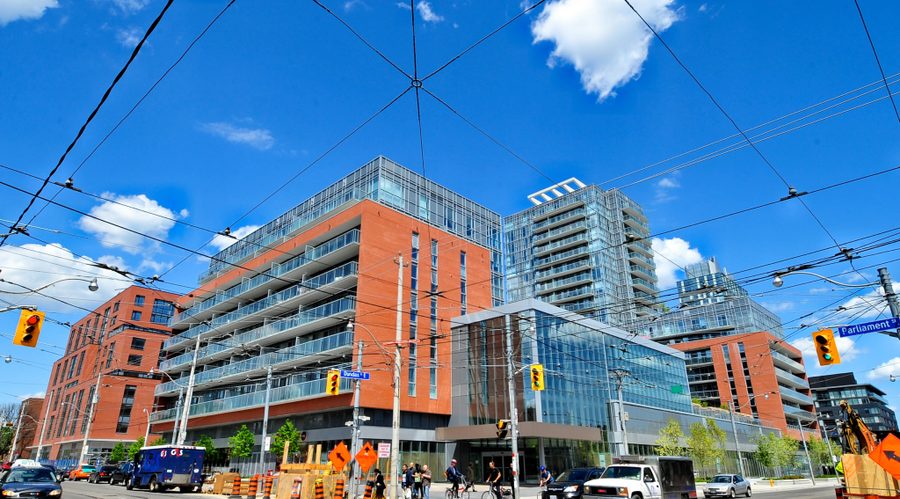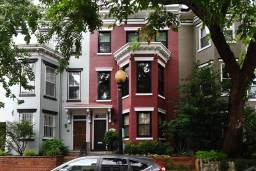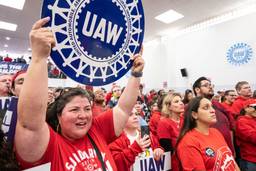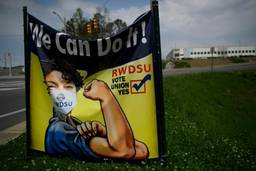Homeownership Is Dead. The Future Lies in Public Housing.
Market-centric housing policies have failed and the path forward is clear: have the government create robust public housing.
Tanner Howard

In 1948, as he planned the first Levittown developments in New York, which would provide homes to thousands of returning white World War II veterans, real estate developer William Leavitt promised U.S. government officials, who sought to contest the growing global influence of the Soviet Union, that “No man who owns his own house and lot can be a Communist. He has too much to do.”
Leavitt’s quote is emblematic of the period of rapid postwar suburbanization in the United States throughout the 1940s and 1950s, during which the Federal Housing Administration underwrote millions of low-cost mortgages for white families. As a result, home ownership became the totemic image of success in the country, a persistent mythology that’s withstood years of decline.
But today, for many of us, this version of the American dream is dead, something that’s become ever more apparent over the last decade. The foreclosure crisis that helped fuel the 2008 financial crash pushed more than nine million families out of their homes between 2006 and 2014, making housing insecurity a growing reality in America.
Last year, more than half a million people were homeless for at least one night, and the homeless population rose in booming cities like New York where affordable housing is scarce but demand is high.
The fate of millennials appears sealed for years to come: homeownership rates for Americans under 35 have fallen by more than 20 percent since 2004. According to a Pew poll, this group is now more likely to be living with their parents than with a partner, the first time that’s been the case in more than 130 years.
It’s an unsettling “new normal” — with nearly half the rental population being rent burdened (paying at least 30 percent of their income on housing). Still, if the betrayed promises of home ownership are no longer meaningful to many, will we be able to build a new sort of egalitarian American dream from the decaying remains of the past?
That’s the vision of “Social Housing in the United States,” a new report from the People’s Policy Project (PPP), an independent think tank headed by left-wing economist and writer Matt Bruenig. In the document, authors Peter Gowan and Ryan Cooper make a compelling case for expanded public housing in the United States.
While the last several decades have seen an increasing emphasis on government-sponsored market-driven solutions to the housing crisis, as the PPP report explains, now may be the perfect time to create something never before seen in the United States: robust, well-maintained, class-diverse public housing.
The mortgage crisis
Homeownership has long been overemphasized in government housing policy. As Derek Thompsons argues at the Atlantic, this has direct impacts on the growth of income inequality: “Federal housing policy transfers lots of money to rich homeowners, a bit less to middle-class homeowners, and practically nothing to poor renters.” Each year, the government forgoes approximately $71 billion in taxes to the Mortgage Interest Deduction, allowing people to deduct the interest costs on their homes. Nearly 90 percent of that money goes to families making $100,000 or more annually.
Middle and lower-income home owning families are far less likely to benefit from these housing policies. The Obama administration failed spectacularly in protecting underwater mortgage holders from refinancing their homes, even as the administration earmarked $75 billion for the purpose. According to another report from PPP, the Home Affordable Mortgage Program, instituted under Obama, ultimately only helped 558,000 families trying to refinance their homes, even as mortgage companies were forced to shell out a $26 billion joint settlement for creating fraudulent documents meant to ensure families were forced from their homes.
The result? Of the 9.3 million foreclosed households, less than a third are likely to purchase a home again. Black and Latino households were particularly undermined by the failures of the Obama administration. Black housing equity declined, on average, by $16,700 during the recession, contributing to a massive uptick in racial wealth disparities.
In a Washington Post op-ed on the declining homeownership rate, Charles Lane observed: “If the Great Recession taught anything, it was that, despite decades of rhetoric about the ‘American Dream’ from real estate lobbyists, politicians and well-meaning low-income-housing advocates, homeownership is not a surefire ticket into the middle class. It can be downright risky.”
Why public housing?
That’s where the fight for public housing comes in. As Gowan and Cooper articulate, the massive influx of new renters, and the complete lack of government involvement in producing new housing units, has given the market overwhelming power to squeeze every last dollar from Americans’ pockets.
Current approaches to stimulating the development of affordable units have largely been failures. For several decades, most affordable housing has been built using the Low-Income Housing Tax Credit (LITHC) program, a tax break that developers sell to investors in exchange for construction loans. With little regulatory oversight, the programs has proven disastrously ineffective: according to a Frontline/NPR investigation, the program currently creates 15 percent fewer units than it did 20 years ago, while costing taxpayers 66 percent more.
However, even this broken system could soon slow down considerably. Because the wealthy need fewer offsets to shrink their yearly tax bill thanks to lower rates for high-income households under the recent GOP tax plan, the LITHC will fund upwards of 200,000 fewer affordable units over the next decade, according to housing advocates.
To Cooper, this model of financing rental housing is woefully inadequate. With the massive monetary sums the government controls, he argues, it should be investing directly in building its own units, instead of chipping away at the problem and leaving deeper structural problems intact.
“Coaxing the private market is not getting the goods, not getting the mass housing that we need,” Cooper says. “You’re talking a couple hundred dollars per rental household, when what you need is lots and lots of new housing units that are priced reasonably and put some downward pressure on the housing market.”
The report offers several models for financing public housing. Importantly, the authors do not believe that public housing should be reserved only for the lowest-income families, as is typical in the United States.
Instead, they emphasize the need for a diverse mixture of tenants, including some who can afford to pay full price, as a means of ensuring that the housing stock does not deteriorate over time and can be self-sustaining. This model is inspired by social housing in Vienna, where three in five people live in government-owned, built or managed housing, and more than 80 percent of the population is eligible for social housing.
“The overall objective should be that you can build so much more of this kind of housing, that you end up with a greater quantity of units, even reserved just for poor people that are scattered through the entire system,” Cooper says.
While making such a massive investment may seem impossible, the money is there: New York alone gave up $1.4 billion in tax income to private developers in 2016, in exchange for a paltry 6,844 affordable units.
In lieu of such wasteful, ineffective spending, we can look to the model of the British Labour Party: With one in three millennials in the UK unlikely to ever own a home, according to a new report, Labour has called to enact rent control and have the government build a million new homes over the next decade, fundamentally challenging the role of the private housing market as the only solution to people’s housing needs.
“We need more places to live in these desirable cities,” Cooper says. “But if we do social housing that’s economically inclusive, we can hit the point in the market where need, not profits, is greatest.”
Changing perceptions
Public housing has gained a tarnished reputation in the United States, with the neglect of federal and local governments making the whole notion of government-owned shelter seem politically unfeasible and morally undesirable. But it wasn’t always this way, especially for those whose housing circumstances were previously far worse.
For hundreds of thousands of Black families, once crowded into kitchenettes as they came north during the Great Migration, the first massive public housing projects, built in tandem with the boom in suburban development in the 1940s and 1950s, were a welcome relief. Clean, well-maintained, and affordable, these dwellings offered dignity and security, something in short supply for low-income city residents.
Sustaining that memory is the mission of the National Public Housing Museum, set to open next year in a former public housing project on Chicago’s West Side. Executive director of the museum Lisa Lee hopes that their preservation efforts can inform the ongoing struggle for more equitable housing policy, one that refuses to give up on public housing as a necessity in our cities.
“The only thing that’s going to save us as a people is a reclamation of the idea of the public and the public good, and to understand that’s why our democracy was so strong as an idea,” Lee says. “That’s what public housing has to be, and it’s one of the last vestiges of it.”
In the introduction to When Public Housing Was Paradise, an oral history collection gathered from Chicago public housing residents, editor J.S. Fuerst argues, “In the last two decades of the twentieth century, American politicians turned away from the idea that government can play a constructive role in addressing social problems.”
The rest of the book describes, in public housing residents’ own words, the magical experience of living in well-built, publicly-owned housing, far removed from a private housing market intent only on maximizing profits. “I moved into [the Harold Ickes Homes] in 1956,” said Vonsell Ashford, a former Chicago Public Schools teacher. “I thought I was moving to paradise. The building was new, and they had a beautiful playground for the children.”
These memories of public housing symbolize the core of the American dream: a better life and a basic sense of dignity. It’s a promise that’s been betrayed in a world of rampant inequality, and one that has rarely been available to generations of low-income communities that have been left behind by market-driven housing policies.
But the possibility of a renewed vision of municipal housing offers a reborn, improved vision of the American Dream, one not rooted in picket-fence suburbia, but instead in the kind of cities we all deserve: affordable, neighborly, spaces where we can grow and thrive together.
“[Public housing] suggests a future in which people can have the type of communities that make city living as good as it can be,” Cooper says. “I like living in cities, but one damaging social characteristic of high-rent cities is that people move around like crazy. I think people generally want a place where you tend to know your neighbors, you can ask people for help, you’re actually a part of an organic community.”

I hope you found this article important. Before you leave, I want to ask you to consider supporting our work with a donation. In These Times needs readers like you to help sustain our mission. We don’t depend on—or want—corporate advertising or deep-pocketed billionaires to fund our journalism. We’re supported by you, the reader, so we can focus on covering the issues that matter most to the progressive movement without fear or compromise.
Our work isn’t hidden behind a paywall because of people like you who support our journalism. We want to keep it that way. If you value the work we do and the movements we cover, please consider donating to In These Times.






